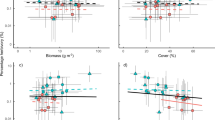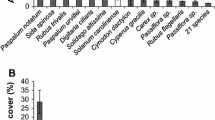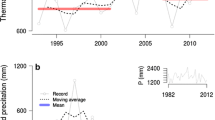Abstract
The rate at which a plant species is attacked by invertebrate herbivores has been hypothesized to depend on plant species richness, yet empirical evidence is scarce. Current theory predicts higher herbivore damage in monocultures than in species-rich mixtures. We quantified herbivore damage by insects and molluscs to plants in experimental plots established in 2002 from a species pool of 60 species of Central European Arrhenatherum grasslands. Plots differed in plant species richness (1, 2, 4, 8, 16, 60 species), number of functional groups (1, 2, 3, 4), functional group and species composition. We estimated herbivore damage by insects and molluscs at the level of transplanted plant individuals (“phytometer” species Plantago lanceolata, Trifolium pratense, Rumex acetosa) and of the entire plant community during 2003 and 2004. In contrast to previous studies, our design allows specific predictions about the relative contributions of functional diversity, plant functional identity, and species richness in relation to herbivory. Additionally, the phytometer approach is new to biodiversity-herbivory studies, allowing estimates of species-specific herbivory rates within the larger biodiversity-ecosystem functioning context. Herbivory in phytometers and experimental communities tended to increase with plant species richness and the number of plant functional groups, but the effects were rarely significant. Herbivory in phytometers was in some cases positively correlated with community biomass or leaf area index. The most important factor influencing invertebrate herbivory was the presence of particular plant functional groups. Legume (grass) presence strongly increased (decreased) herbivory at the community level. The opposite pattern was found for herbivory in T. pratense phytometers. We conclude that (1) plant species richness is much less important than previously thought and (2) plant functional identity is a much better predictor of invertebrate herbivory in temperate grassland ecosystems.




Similar content being viewed by others
References
Andow DA (1990) Population dynamics of an insect herbivore in simple and diverse habitats. Ecology 71:1006–1017
Andow DA (1991) Vegetational diversity and arthropod population response. Ann Rev Entomol 36:561–586
Bahr C (2005) Effects of plant species diversity, identity and architectural density on the density of slugs in an experimental grassland. Diploma Thesis, University of Jena (in German)
Bernays E, Graham M (1988) On the evolution of host specificity in Phytophagous Arthropods. Ecology 69:886–892
Brown VK, Gange AC (1989) Differential effects of above- and below-ground insect herbivory during early plant succession. Oikos 54:67–76
Burnham KP, Anderson DA (1998) Model selection and inference—a practical information—theoretic approach. Springer, Berlin Heidelberg New York
Carson WP, Root RB (1999) Top-down effects of insect herbivores during early sucession: influence on biomass and plant dominance. Oecologia 121:260–272
Crawley MJ (1989) Insect herbivores and plant population dynamics. Ann Rev Entomol 34:531–564
Crawley MJ (2002) Statistical computing. An introduction to data analysis using S-Plus. Wiley, Chichester
Ellenberg H (1996) Vegetation Mitteleuropas mit den Alpen, 5 edn. Ulmer, Stuttgart
Finch S, Collier RH (2000) Host-plant selection by insects—a theory based on ‘appropriate/inappropriate landings’ by pest insects of cruciferous plants. Entomol Exp Appl 96:91–102
Gibson DJ (2002) Methods in comparative plant population ecology. Oxford University Press, Oxford
Giller PS, O´Donovan G (2002) Biodiversity and ecosystem function: do species matter? Biology and environment Proc R Ir Acad 102B:129–139
Haddad NM, Tilman D, Haarstad J, Ritchie ME, Knops JMH (2001) Contrasting effects of plant richness and composition on insect communities: a field experiment. Am Nat 158:17–35
Hassell MP (2000) The spatial and temporal dynamics of host-parasitoid interactions. Oxford University Press, Oxford
Hulme PE (1996) Herbivores and the performance of grassland plants: a comparison of arthropod, mollusc and rodent herbivory. J Ecol 84:43–51
Knops JMH, Tilman D, Haddad NM, Naeem S, Mitchell CE, Haarstad J, Ritchie ME, Howe KM, Reich PB, Siemann E, Groth J (1999) Effects of plant species richness on invasion dynamics, disease outbreaks, insect abundances and diversity. Ecol Lett 2:286–293
Koricheva J, Mulder CPH, Schmid B, Joshi J, Huss-Danell K (2000) Numerical responses of different trophic groups of invertebrates to manipulations of plant diversity in grassland. Oecologia 125:271–282
Kowalski E (2005) Density patterns of invertebrate herbivores (Auchenorrhyncha and Heteroptera) along a diversity gradient in an experimental grassland. Diploma Thesis, University of Jena (in German)
Kubitzky K (ed) (1993) The families and genera of vascular plants. Springer, Berlin Heidelberg New York
Kyto M, Niemela P, Larsson S (1996) Insects on trees: population and individual response to fertilization. Oikos 75:148–159
Mitchell CE (2003) Trophic control of grassland production and biomass by pathogens. Ecol Lett 6:147–155
Mulder CPH, Jumpponen A, Hogberg P, Huss-Danell K (2002) How plant diversity and legumes affect nitrogen dynamics in experimental grassland communities. Oecologia 133:412–421
Mulder CPH, Koricheva J, Huss-Danell K, Högberg P, Joshi J (1999) Insects affect relationships between plant species richness and ecosystem processes. Ecol Lett 2:237–246
O’Neal ME, Landis DA, Isaacs R (2002) An inexpensive, accurate method for measuring leaf area and defoliation through digital image analysis. J Econ Entomol 95:1190–1194
Perner J, Wytrykush C, Kahmen A, Buchmann N, Egerer I, Creutzburg S, Odat N, Audorff V, Weisser WW (2005) Effects of plant diversity, plant productivity and habitat parameters on arthropod abundance in montane European grasslands. Ecography 28:429–442
Pfisterer AB, Diemer M, Schmid B (2003) Dietary shift and lowered biomass gain of a generalist herbivore in species-poor experimental plant communities. Oecologia 135:234–241
Root RB (1973) Organization of a plant-arthropod association in simple and diverse habitats: The fauna of collards (Brassica oleracea). Ecol Monogr 43:95–124
Roscher C, Schumacher J, Baade J, Wilcke W, Gleixner G, Weisser WW, Schmid B, Schulze ED (2004) The role of biodiversity for element cycling and trophic interactions: an experimental approach in a grassland community. Basic Appl Ecol 5:107–121
Roscher C, Temperton VM, Scherer-Lorenzen M, Schmitz M, Schumacher J, Schmid B, Buchmann N, Weisser WW, Schulze ED (2005) Overyielding in experimental grassland communities—irrespective of species pool or spatial scale. (vol 8, pg 419, 2005). Ecol Lett 8:576–577
Schmid B, Hector A, Huston MA, Inchausti P, Nijs I, Leadley PW, Tilman D (2002) The design and analysis of biodiversity experiments. In: Inchausti P (ed) Biodiversity and Ecosystem Functioning: Synthesis and Perspectives. Oxford University Press, Oxford, pp 61–75
Sedlacek JD, Barrett GW, Shaw DR (1988) Effects of nutrient enrichment on the Auchenorrhyncha (Homoptera) in contrasting grassland communities. J Appl Ecol 25:537–550
Siemann E (1998) Experimental tests of effects of plant productivity and diversity on grassland arthropod diversity. Ecology 79:2057–2070
Siemann E, Tilman D, Haarstad J, Ritchie M (1998) Experimental tests of the dependence of arthropod diversity on plant diversity. Am Nat 152:738–750
Spehn EM, Scherer-Lorenzen M, Schmid B, Hector A, Caldeira MC, Dimitrakopoulos PG, Finn JA, Jumpponen A, O’Donnovan G, Pereira JS, Schulze ED, Troumbis AY, Korner C (2002) The role of legumes as a component of biodiversity in a cross-European study of grassland biomass nitrogen. Oikos 98:205–218
Stamp NE, Bowers MD (2000) Foraging behaviour of caterpillars given a choice of plant genotypes in the presence of insect predators. Ecol Entomol 25:486–492
Tahvanainen JO, Root RB (1972) Influence of vegetational diversity on the population ecology of a specialized herbivore, Phyllotreta cruciferae (Coloeoptera: Chrysomelidae). Oecologia 10:321–346
Tilman D, Knops J, Wedin D, Reich P, Ritchie M, Siemann E (1997) The influence of functional diversity and composition on ecosystem processes. Science 277:1300–1305
Tonhasca A, Byrne DN (1994) The effects of crop diversification on herbivorous insects: A meta-analysis approach. Ecol Entomol 19:239–244
Tscharntke T, Greiler H-J (1995) Insect communities, grasses, and grasslands. Ann Rev Entomol 40:535–558
Unsicker S, Renker C, Kahmen A, Spindler S, Buchmann N, Weisser WW (2005) Testing the efficiency of three 15N-labeled nitrogen compounds for indirect labeling of grasshoppers via plants in the field. Entomol Exp Appl 116 (in press)
Voigt W, Perner J, Davis AJ, Eggers T, Schumacher J, Bahrmann R, Fabian B, Heinrich W, Kohler G, Lichter D, Marstaller R, Sander FW (2003) Trophic levels are differentially sensitive to climate. Ecology 84:2444–2453
Zangerl AR, Hamilton JG, Miller TJ, Crofts AR, Oxborough K, Berenbaum MR, de Lucia EH (2002) Impact of folivory on photosynthesis is greater than the sum of its holes. PNAS 99:1088–1091
Acknowledgements
We thank Mick J. Crawley for his generous encouragement and advice in statistical analysis. Winfried Voigt kindly provided data on invertebrate abundances, and the technical assistance of Sylvia Creutzburg and Nadine Mitschunas is greatly acknowledged. We thank Ernst-Detlef Schulze, Christian Körner, and two anonymous referees for many helpful comments on a previous version of this manuscript. This study was supported by the Deutsche Forschungsgemeinschaft through grants WE2618/4-1 and FOR 456 to WWW. CS was supported by the Studienstiftung des Deutschen Volkes. All experiments conducted comply with current German laws.
Author information
Authors and Affiliations
Corresponding author
Additional information
Communicated by Christian Koerner
Rights and permissions
About this article
Cite this article
Scherber, C., Mwangi, P.N., Temperton, V.M. et al. Effects of plant diversity on invertebrate herbivory in experimental grassland. Oecologia 147, 489–500 (2006). https://doi.org/10.1007/s00442-005-0281-3
Received:
Accepted:
Published:
Issue Date:
DOI: https://doi.org/10.1007/s00442-005-0281-3




